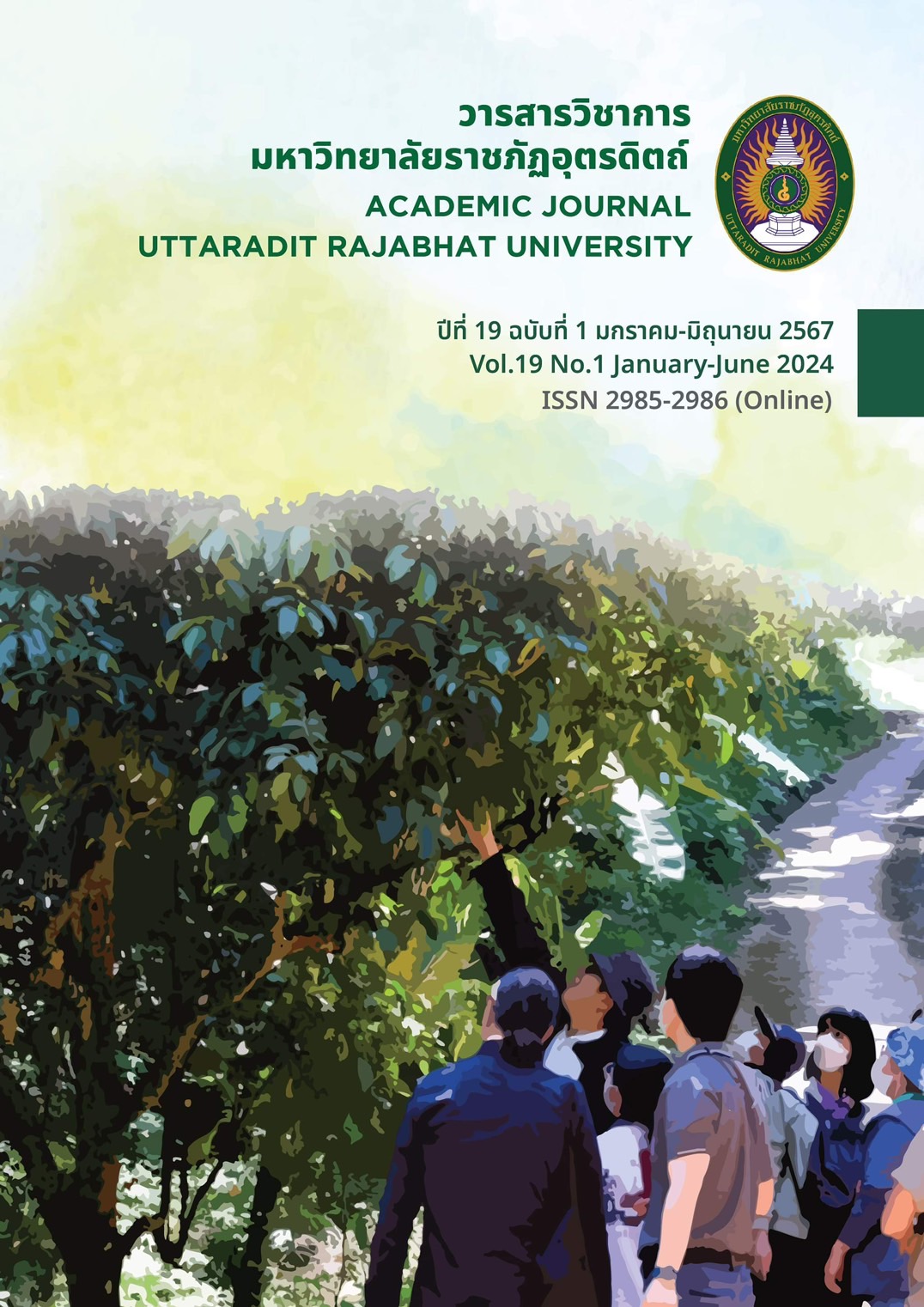EFFECTS OF GRANULAR ORGANIC FERTILIZER, CHEMICAL AND GRANULAR ORGANIC FERTILIZER WITH HORMONE MIXED FORMULA (HO), AND CHEMICAL FERTILIZER ON GROWTH AND BIOMASS ACCUMULATION OF CASSAVA
Main Article Content
Abstract
The objective of this research was to investigate the effects of granular organic fertilizer, chemical, granular organic fertilizer with hormone mixed formula (HO), and chemical fertilizer on effects within soil properties, growth, and biomass accumulation of cassava (Manihot esculenta, Crantz). The study examined the effects of four types of fertilizers: 1) organic granular fertilizer (ORG), 2) chemical and organic granular fertilizer with hormone mixed formula (HO-1), 3) chemical and organic granular fertilizer with hormone mixed formula (HO-2), and 4) chemical fertilizer (CHEM) with a grade of 15-15-15, applied at the rates of 50 and 100 kilograms per rai. The experimental design was a randomized complete block design (RCBD) with 9 treatments, 4 replications. The results indicated that the soil before the study had low fertility. However, after the study, it was found that the application of HO-1 (T5) and HO-2 (T7) at a rate of 100 kilograms per rai increased the overall plant nutrient content of the soil and improved some physical properties such as bulk density (BD), porosity (E), and field capacity (FC) compared to chemical and granular organic fertilizers. Regarding the growth of cassava, it was observed that the application of HO-1 at a rate of 100 kilograms per rai (T5) resulting in better stem size (diameter), canopy size, and leaf chlorophyll content compared to other treatments. As for the biomass accumulation of cassava at 8 months of age, it was found to be highest in the trunk, branch, leaf, root, and leaf stalk respectively. It was found that the use of HO-1 (T5) and HO-2 (T7) had the highest dry weight accumulation in the tubers (starch content) at 34.5% and 34.3%, respectively, which was higher than other treatments. Based on the results of this study, chemical and organic granular fertilizer with hormone mixed formula (HO) can be considered as an alternative option for soil and fertilizer management in the cultivation of other varieties of cassava to achieve higher quantity and quality.
Downloads
Article Details

This work is licensed under a Creative Commons Attribution-NonCommercial-NoDerivatives 4.0 International License.
References
กองวิเคราะห์ดิน. (2540). คุณสมบัติทางกายภาพและเคมีดินกับการวิเคราะห์ดินในห้องปฏิบัติการ. กรมพัฒนาที่ดิน กระทรวงเกษตรและสหกรณ์.
ชวลิต รักษาริกรณ์, พรทิพย์ ภาษี, และภูมิศักดิ์ อินทนนท์. (2555). อิทธิพลของปุ๋ยเคมี และปุ๋ยฮอร์โมนปั้นเม็ดสูตรผสมที่มีผลต่อการเจริญเติบโตของยางพารา. Naresuan University Journal: Science and Technology (NUJST), 20(3), 18-28.
ชาติประชา สอนกลิ่น. (2563). อิทธิพลของปุ๋ยฮอร์โมนปั้นเม็ดสูตรผสม (HO) ที่มีต่อผลผลิตและคุณภาพดาวเรือง. [วิทยานิพนธ์ปรัชญาดุษฎีบัณฑิต มหาวิทยาลัยนเรศวร].
บุญรัตน์ ประทุมชาติ. (2553). ผลของการใช้แป้งมันสำปะหลังเพื่อเป็นแหล่งคาร์โบไฮเดรตในสูตรอาหารกุ้งต่อการเจริญเติบโตความแปรปรวนของขนาด อัตราการแลกเนื้อ ความถี่ในการลอกคราบ อัตราการรอดและดัชนีตับของกุ้งขาววัยรุ่น (Litopenaeus vannamei). วารสารวิทยาศาสตร์บูรพา, 15(2), 29-36.
พิทักษ์พงศ์ ป้อมปราณี. (2560). ธาตุอาหารพืช (เอกสารประกอบการสอน รายวิชา ปฐพีวิทยา). คณะวิทยาศาสตร์และเทคโนโลยี, มหาวิทยาลัยราชภัฏนครปฐม.
ภูมิศักดิ์ อินทนนท์. (2555). เทคโนโลยีปุ๋ย. ภาควิชาวิทยาศาสตร์การเกษตร คณะเกษตรศาสตร์ทรัพยากรธรรมชาติและสิ่งแวดล้อม มหาวิทยาลัยนเรศวร.
วัลลีย์ อมรพล, กอบเกียรติ ไพศาลเจริญ, ศรีสุดา ทิพยรักษ์, ศุภกาญจน์ ล้วนมณี, จิณณจาร์ หาญเศรษฐสุข, ประพิศ วองเทียม, และสมพงษ์ ทองช่วย. (2560). การศึกษาอัตราปุ๋ยเคมีที่เหมาะสมสำหรับมันสำปะหลังที่ปลูกในกลุ่มดินร่วนปนทราย : ชุดดินห้วยโป่ง. วารสารวิชาการเกษตร, 35(2), 151-163.
วิชาญ ชุ่มมั่น และภูมิศักดิ์ อินทนนท์. (2559). อิทธิพลของปุ๋ยฮอร์โมนปั้นเม็ดสูตรผสมที่มีต่อการเจริญเติบโตและผลผลิต และส่งผลต่อปริมาณการเข้าทำลายของเพลี้ยกระโดดสีน้ำตาล. วารสารแก่นเกษตร, 44(2), 265-274.
วิภาวรรณ สายคำยศ, จันทร์เพ็ญ ชุมแสง, และภูมิศักดิ์ อินทนนท์. (2561). อิทธิพลของปุ๋ยฮอร์โมนปั้นเม็ดสูตรผสม (HO) และปุ๋ยเคมีที่ใช้ร่วมกับปูนขาวที่มีต่อสมบัติของดินและผลผลิตปาล์มน้ำมัน. วารสารวิทยาศาสตร์เกษตร, 49(19 พิเศษ), 199-206.
ศูนย์เทคโนโลยีสารสนเทศและการสี่อสาร กรมวิชาการเกษตร. (2566). การจำแนกพันธุ์มันสำปะหลัง. กรมวิชาการเกษตร. https://at.doa.go.th/cassvar/varR9.html
สมลักษณ์ จูฑังคะ. (2551). เอกสารวิชาการ เทคโนโลยีการผลิตมันสำปะหลัง. กรมวิชาการเกษตร.
สำนักงานเกษตรจังหวัดอุตรดิตถ์. (2564). แผนพัฒนาการเกษตรและสหกรณ์ของจังหวัดอุตรดิตถ์ (พ.ศ. 2561 – 2565) ฉบับทบทวน ปีงบประมาณ พ.ศ 2564. https://www.opsmoac.go.th/uttaradit-strategic-files-441991791797
สำนักงานเศรษฐกิจการเกษตร. (2565). แนวทางการจัดทำเขตส่งเสริมการปลูกพืชเศรษฐกิจที่สำคัญ. กระทรวงเกษตรและสหกรณ์. https://www.oae.go.th/assets/portals/1/files/jounal/2565/Guidelineseconomiccrops2565.pdf
สุพัตรา ชาวกงจักร์, นิมิตร วงศ์สุวรรณ, ศศิธร ประพรม, และนฤทัย วรสถิตย์. (2566). ลดต้นทุนการใช้ปุ๋ยเคมีและเพิ่มผลผลิตมันสำปะหลัง ด้วยเทคโนโลยีการใช้ปุ๋ยในแหล่งปลูก จังหวัดกาฬสินธุ์. วารสารแก่นเกษตร, 51(suppl. 1), 116–123.
เอนกพงศ์ จำปา และวิทยา ตรีโลเกศ. (2561). การประยุกต์ใช้อัตราและสูตรปุ๋ยเคมีที่แตกต่างกัน ในการปลูกมันสำปะหลัง KU 50 ในดินทราย. วารสารดินและปุ๋ย, 40(1), 55-64.
Intanon, P. (2013). The influence of different types of fertilizers on productivity and quality of maize in the area of Kwaew Noi Bamrungdan Dam, Phitsanulok province, Thailand. International Journal of Environmental and Rural Development, 4(2), 15-20. https://doi.org/10.32115/ijerd.4.2_15
Intanon, P., Keteku, A. K., & Intanon, R., (2017, December 12-15). Effect of different materials on soil pH improvement, soil properties, growth, yield and quality of sugarcane [Conference]. 13th International Conference of the East and Southeast Asia Federation of Soil Science Societies, Pattaya, Thailand.

